New Image Texture Feature for Chest X-Ray Classification
Abstract
Full Text:
PDFReferences
K. Roosa et al., “Real-time forecasts of the COVID-19 epidemic in China from February 5th to February 24th, 2020,” Infect. Dis. Model., vol. 5, pp. 256–263, 2020, doi: 10.1016/j.idm.2020.02.002.
W. M. Shaban, A. H. Rabie, A. I. Saleh, and M. A. Abo-Elsoud, “A new COVID-19 Patients Detection Strategy (CPDS) based on hybrid feature selection and enhanced KNN classifier,” Knowledge-Based Syst., vol. 205, p. 106270, 2020, doi: 10.1016/j.knosys.2020.106270.
V. K. Gupta, A. Gupta, D. Kumar, and A. Sardana, “Prediction of COVID-19 confirmed, death, and cured cases in India using random forest model,” Big Data Min. Anal., vol. 4, no. 2, pp. 116–123, 2021, doi: 10.26599/BDMA.2020.9020016.
T. Yan, P. K. Wong, H. Ren, H. Wang, J. Wang, and Y. Li, “Automatic distinction between COVID-19 and common pneumonia using multi-scale convolutional neural network on chest CT scans,” Chaos, Solitons and Fractals, vol. 140, p. 110153, 2020, doi: 10.1016/j.chaos.2020.110153.
L. Sun et al., “Adaptive Feature Selection Guided Deep Forest for COVID-19 Classification with Chest CT,” IEEE J. Biomed. Heal. INFORMATICS, vol. 24, no. 10, pp. 2798–2805, 2020.
J. Zhang, Y. Chu, and N. Zhao, “Supervised framework for COVID-19 classification and lesion localization from chest CT,” Ethiop. J. Heal. Dev., vol. 34, no. 4, pp. 235–242, 2020.
R. C. Joshi et al., “A deep learning-based COVID-19 automatic diagnostic framework using chest X-ray images,” Biocybern. Biomed. Eng., vol. 41, no. 1, pp. 239–254, 2021, doi: 10.1016/j.bbe.2021.01.002.
Z. Wang et al., “Automatically discriminating and localizing COVID-19 from community-acquired pneumonia on chest X-rays,” Pattern Recognit., vol. 110, 2021, doi: 10.1016/j.patcog.2020.107613.
J. D. Arias-Londono, J. A. Gomez-Garcia, L. Moro-Velazquez, and J. I. Godino-Llorente, “Artificial Intelligence applied to chest X-Ray images for the automatic detection of COVID-19. A thoughtful evaluation approach,” IEEE Access, vol. 8, pp. 226811–226827, 2020, doi: 10.1109/ACCESS.2020.3044858.
P. Torkian, H. Rajebi, T. Zamani, N. Ramezani, P. Kiani, and S. Akhlaghpoor, “Magnetic resonance imaging features of coronavirus disease 2019 (COVID-19) pneumonia: The first preliminary case series,” Clin. Imaging, vol. 69, no. 5, pp. 261–265, 2021, doi: 10.1016/j.clinimag.2020.09.002.
A. Gupta, Anjum, S. Gupta, and R. Katarya, “InstaCovNet-19: A deep learning classification model for the detection of COVID-19 patients using Chest X-ray,” Appl. Soft Comput., vol. 99, p. 106859, 2021, doi: 10.1016/j.asoc.2020.106859.
E. Hussain, M. Hasan, M. A. Rahman, I. Lee, T. Tamanna, and M. Z. Parvez, “CoroDet: A deep learning based classification for COVID-19 detection using chest X-ray images,” Chaos, Solitons and Fractals, vol. 142, p. 110495, 2021, doi: 10.1016/j.chaos.2020.110495.
E. F. Ohata et al., “Automatic detection of COVID-19 infection using chest X-ray images through transfer learning,” IEEE/CAA J. Autom. Sin., vol. 8, no. 1, pp. 239–248, 2021, doi: 10.1109/JAS.2020.1003393.
D. Yousri, M. Abd Elaziz, L. Abualigah, D. Oliva, M. A. A. Al-qaness, and A. A. Ewees, “COVID-19 X-ray images classification based on enhanced fractional-order cuckoo search optimizer using heavy-tailed distributions,” Appl. Soft Comput., vol. 101, p. 107052, 2021, doi: 10.1016/j.asoc.2020.107052.
Y. H. Wu et al., “JCS: An Explainable COVID-19 Diagnosis System by Joint Classification and Segmentation,” IEEE Trans. Image Process., vol. 30, pp. 3113–3126, 2021, doi: 10.1109/TIP.2021.3058783.
L. Wang et al., “Multi-classifier-based identification of COVID-19 from chest computed tomography using generalizable and interpretable radiomics features,” Eur. J. Radiol., vol. 136, p. 109552, 2021, doi: 10.1016/j.ejrad.2021.109552.
A. Sayg?l?, “A new approach for computer-aided detection of coronavirus (COVID-19) from CT and X-ray images using machine learning methods,” Appl. Soft Comput., vol. 105, p. 107323, 2021, doi: 10.1016/j.asoc.2021.107323.
S. Varela-Santos and P. Melin, “A new approach for classifying coronavirus COVID-19 based on its manifestation on chest X-rays using texture features and neural networks,” Inf. Sci. (Ny)., vol. 545, pp. 403–414, 2021, doi: 10.1016/j.ins.2020.09.041.
Y. Peng, Y. Tang, S. Lee, Y. Zhu, R. M. Summers, and Z. Lu, “COVID-19-CT-CXR: A freely accessible and weakly labeled chest X-Ray and CT image collection on COVID-19 from biomedical literature,” IEEE Trans. Big Data, vol. 7, no. 1, pp. 3–12, 2021, doi: 10.1109/TBDATA.2020.3035935.
B. Hochhegger et al., “Coronavirus Disease 2019 (COVID-19) Pneumonia Presentations in Chest Computed Tomography: A Pictorial Review,” Curr. Probl. Diagn. Radiol., vol. 50, no. 3, pp. 436–442, 2021, doi: 10.1067/j.cpradiol.2020.06.010.
H. X. Bai et al., “Performance of Radiologists in Differentiating COVID-19 from Non-COVID-19 Viral Pneumonia at Chest CT,” Radiology, vol. 296, no. 2, pp. E46–E54, 2020, doi: 10.1148/radiol.2020200823.
F. Xiong et al., “The clinical classification of patients with COVID-19 pneumonia was predicted by Radiomics using chest CT,” Medicine (Baltimore)., vol. 100, no. 12, pp. 1–8, 2021, doi: 10.1097/MD.0000000000025307.
T. Tuncer, F. Ozyurt, S. Dogan, and A. Subasi, “A novel Covid-19 and pneumonia classification method based on F-transform,” Chemom. Intell. Lab. Syst., vol. 210, no. January, p. 104256, 2021, doi: 10.1016/j.chemolab.2021.104256.
M. E. H. Chowdhury et al., “Can AI help in screening viral and COVID-19 pneumonia?,” IEEE Access, vol. 8, pp. 132665–132676, 2020.
DOI: https://doi.org/10.33633/jais.v7i1.5340
Article Metrics
Abstract view : 213 timesPDF - 149 times
Refbacks
- There are currently no refbacks.
Journal of Applied Intelligent System (e-ISSN : 2502-9401, p-ISSN : 2503-0493) is published by Department of Informatics Universitas Dian Nuswantoro Semarang and IndoCEISS.


Journal of Applied Intelligent System indexed by :
This journal is under licensed of Creative Commons Attribution 4.0 International License.

_.png)







